Intel Unveils 22 More Affordable Alder Lake-S Desktop Chips, New Laminar Coolers
New Alder Lake SKUs, B660 boards, Coolers and benchmarks revealed
Intel’s CES 2022 keynote found the company introducing the remaining 22 Alder Lake-S chips that will round out its lineup for desktop PCs as it looks to solidify its position at the top of the Best CPU for gaming lists. The company also announced that the more affordable H670, B660 and H610 chipsets would come to market soon, helping to address the high platform pricing associated with the pricier Z690 motherboards.
Intel also shared details about its new Laminar lineup of stock coolers that come bundled with its non-K SKUs. These new coolers appear to add plenty of new cooling capabilities in tandem with some RGB bling, both of which are sorely needed to compete with AMD’s historically excellent Ryzen stock coolers. Let’s dive in.
Intel Alder Lake-S Specifications and Pricing
Here we can see Intel’s 22 new 65W and 35W chips that complement the three Alder Lake models (Core i9-12900K, Core i7-12700K, and Core i5-12600K) already on the market. As before, most of these chips come in two variants — one full-fledged SKU with graphics and a graphics-less F-series model that comes with a discount. These chips all follow the same basic principles as the K-series SKUs and support additives like DDR4-3200 and DDR5-4800 memory, along with the PCIe 4.0 and 5.0 interface. You can read more about the architecture and all of its features in our Alder Lake overview.
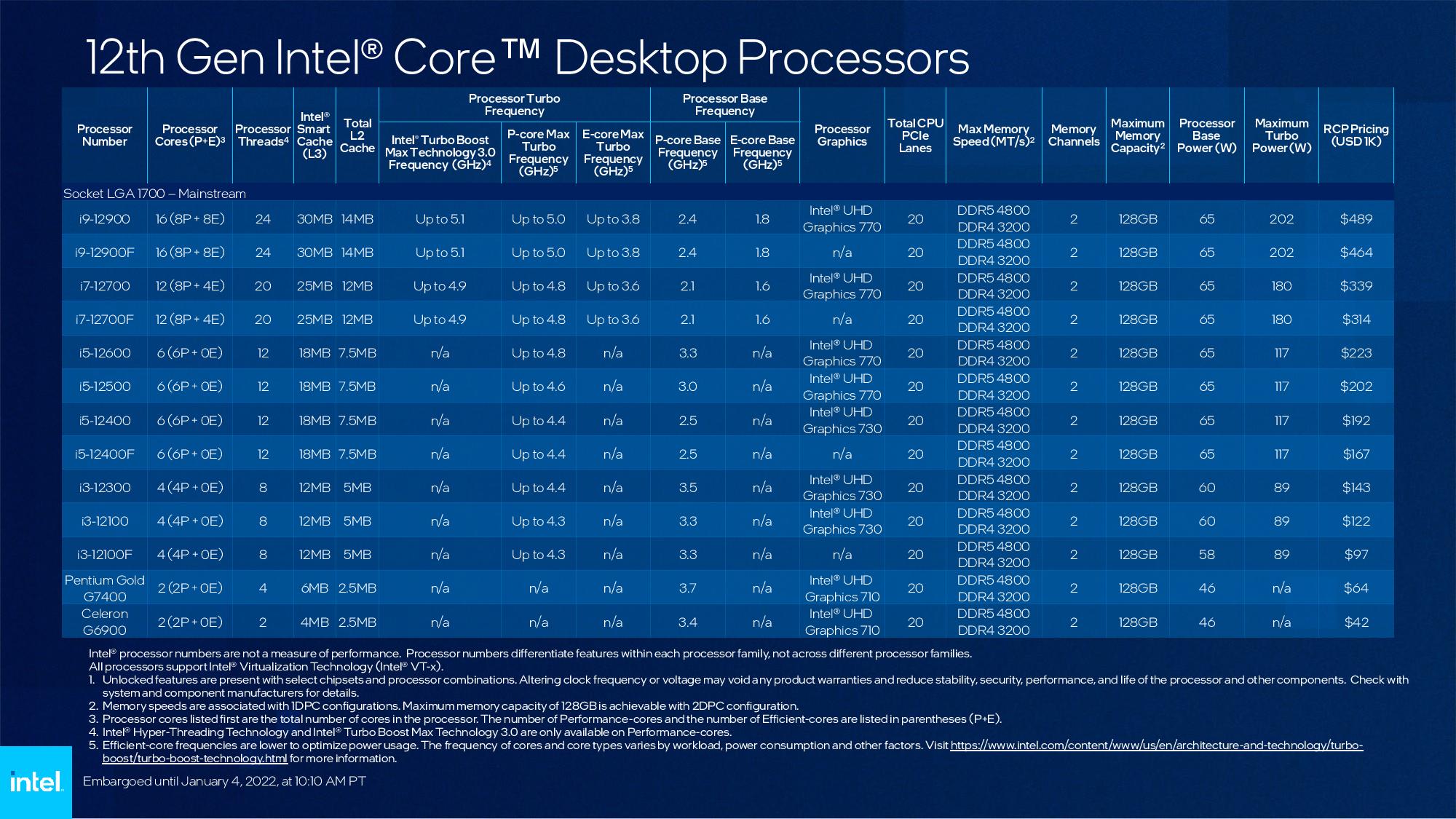
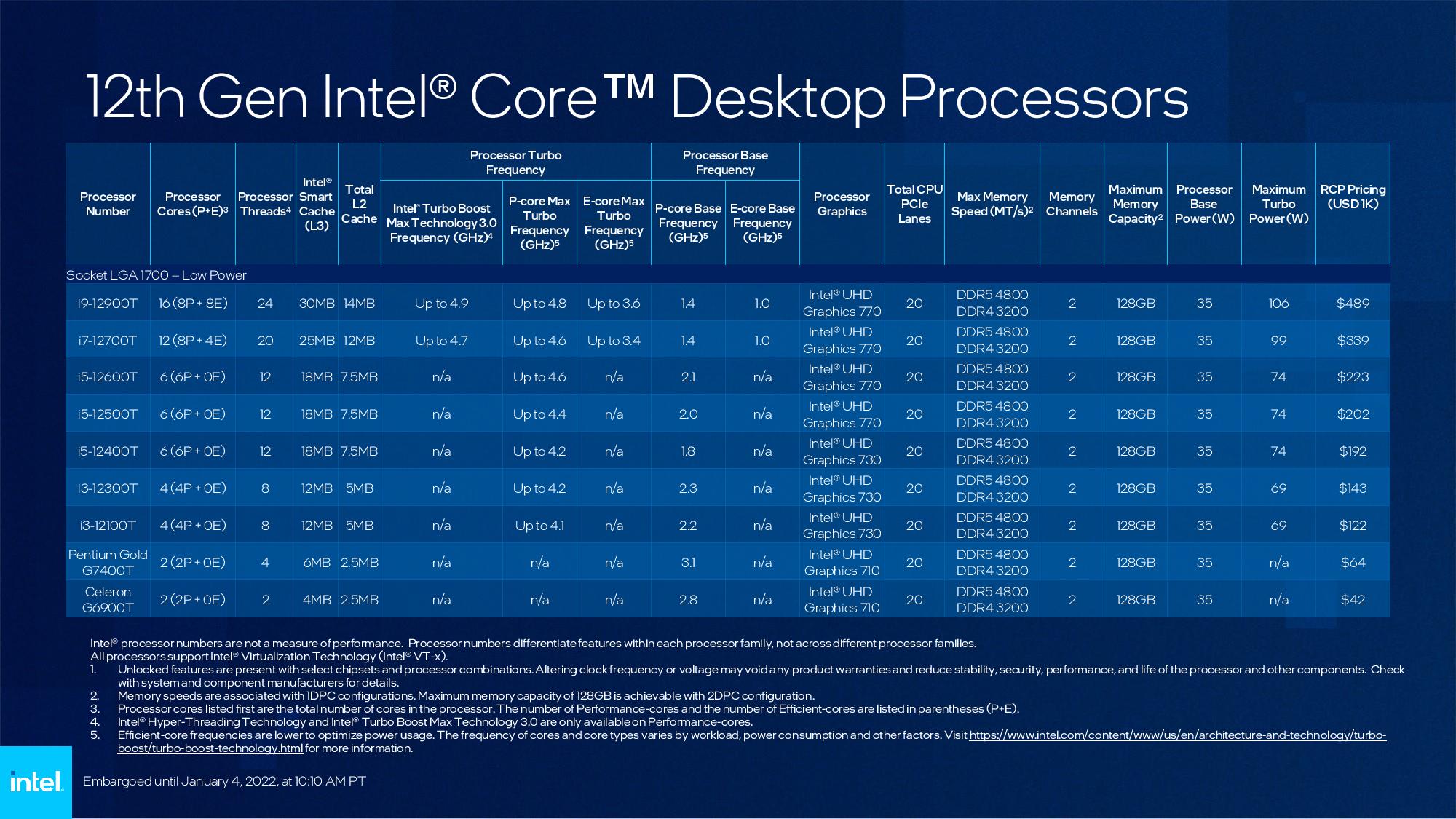
All of these new chips feature locked multipliers, meaning they aren’t overclockable. Still, Intel’s new policy of allowing memory overclocking on all of its chips means you can eke out impressive gains with a minimum of fuss. In fact, we recently displayed just that in our Core i5-12400 review that we posted ahead of the official chip launch today.
Speaking of which, the six-core 12-thread Core i5-12400 stands out as the go-to chip for gamers with its excellent blend of performance for a mere $192. This chip comes without E-cores, meaning it doesn’t have the hybrid x86 architecture as we see in many of the Alder Lake chips, but that doesn’t hamper its competitiveness in its price range. In fact, our review shows that this chip matches the gaming performance of the previous-gen $549 flagship Core i9-11900K and even beats AMD’s $300 Ryzen 5 5600X, setting a new bar for mainstream gaming processors.
The Core i5 series is attractive, with prices spanning from $223 Core i5-12600 to the $167 Core i5-12400, but the latter chip is the real standout in this price range if you plan on gaming with a discrete GPU. Stepping up to the higher-end 12500 or 12600 provides a step forward to the UHD Graphics 770 engine, so these chips are more attractive for pre-built systems or if you don’t plan on using a discrete GPU.
The higher-end $489 Core i9-12900 and $339 Core i7-12700 models are almost identical to their K-series counterparts, so they come with varying numbers of E-cores, but they also have lower clock speeds to stay within the lower 65W PBP/TDP rating. That’s a significant reduction from the K-series’ 125W rating. In addition, Intel also reduced the Maximum Turbo Power (MTP) on the Core i9 and i7 models by 39W and 10W, respectively. Naturally, these power consumption alterations result in less performance, but it also provides a cooler system and friendlier price tag than the K-series chips.
Intel’s Core i3 lineup also appears to be impressive with four performance cores (these chips also don’t have E-cores) and eight threads paired with the UHD Graphics 730 engine. Pricing ranges from the $97 Core i3-12100F to the $143 Core i3-12300, both of which appear to be stellar chips for the low end. Unfortunately, both Intel and AMD have mostly abandoned the sub-$140 market in the wake of the ongoing chip shortages, so supply has been short, but hopefully, we’ll see these processors become more readily available for DIYers.
Intel also introduced its $64 Pentium Gold G7400 and $42 Celeron G6900 processors for the ultra low-end. These dual-core chips come with four threads and have a very limited UHD Graphics 710 engine. Intel’s T-series chips, which come with a 35W TDP and are popular for small form factor systems like HTPCs and builds with passive cooling, are also available in a broad range of configurations.
Intel Alder Lake-S 65W and 35W Benchmarks
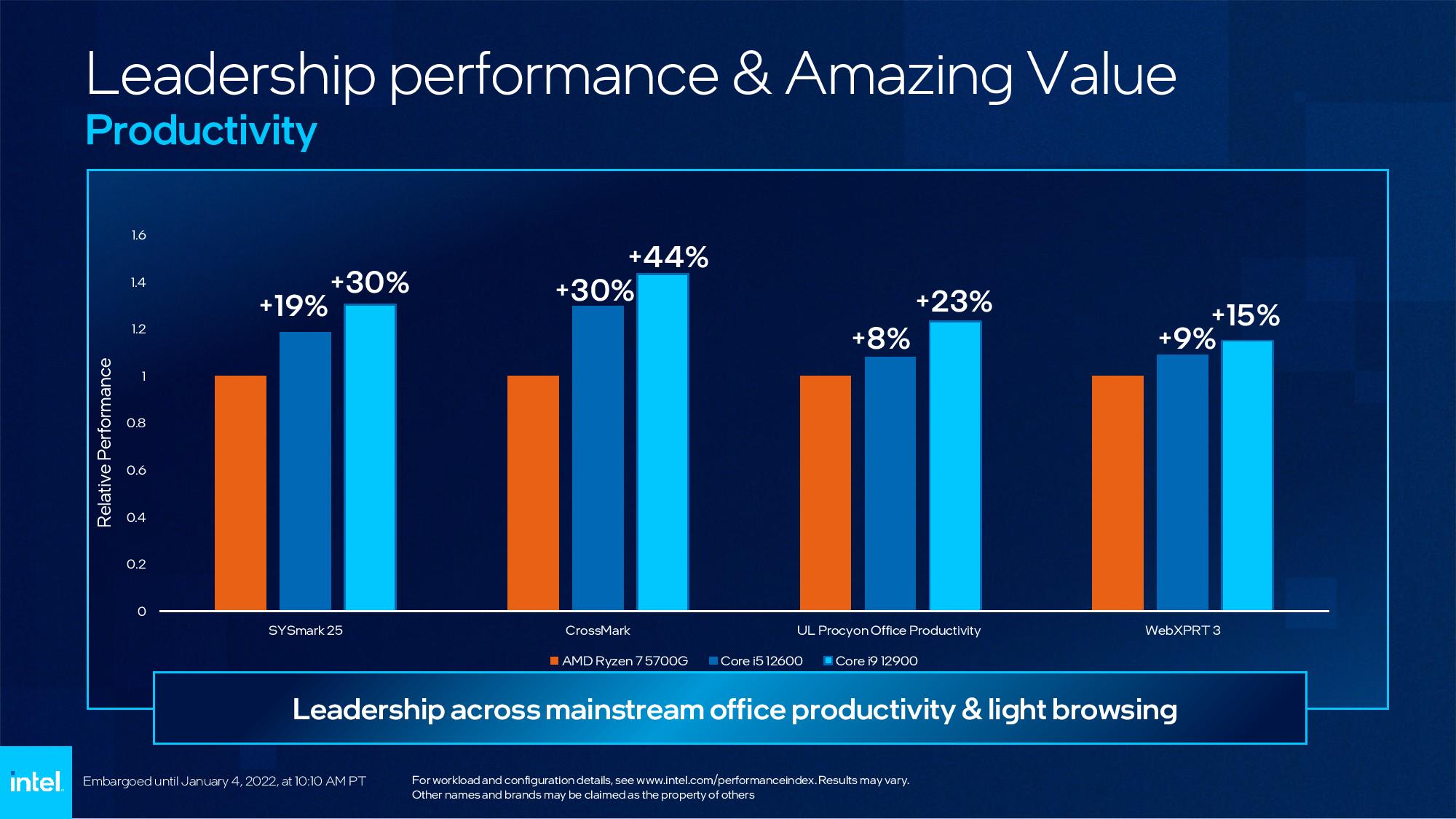

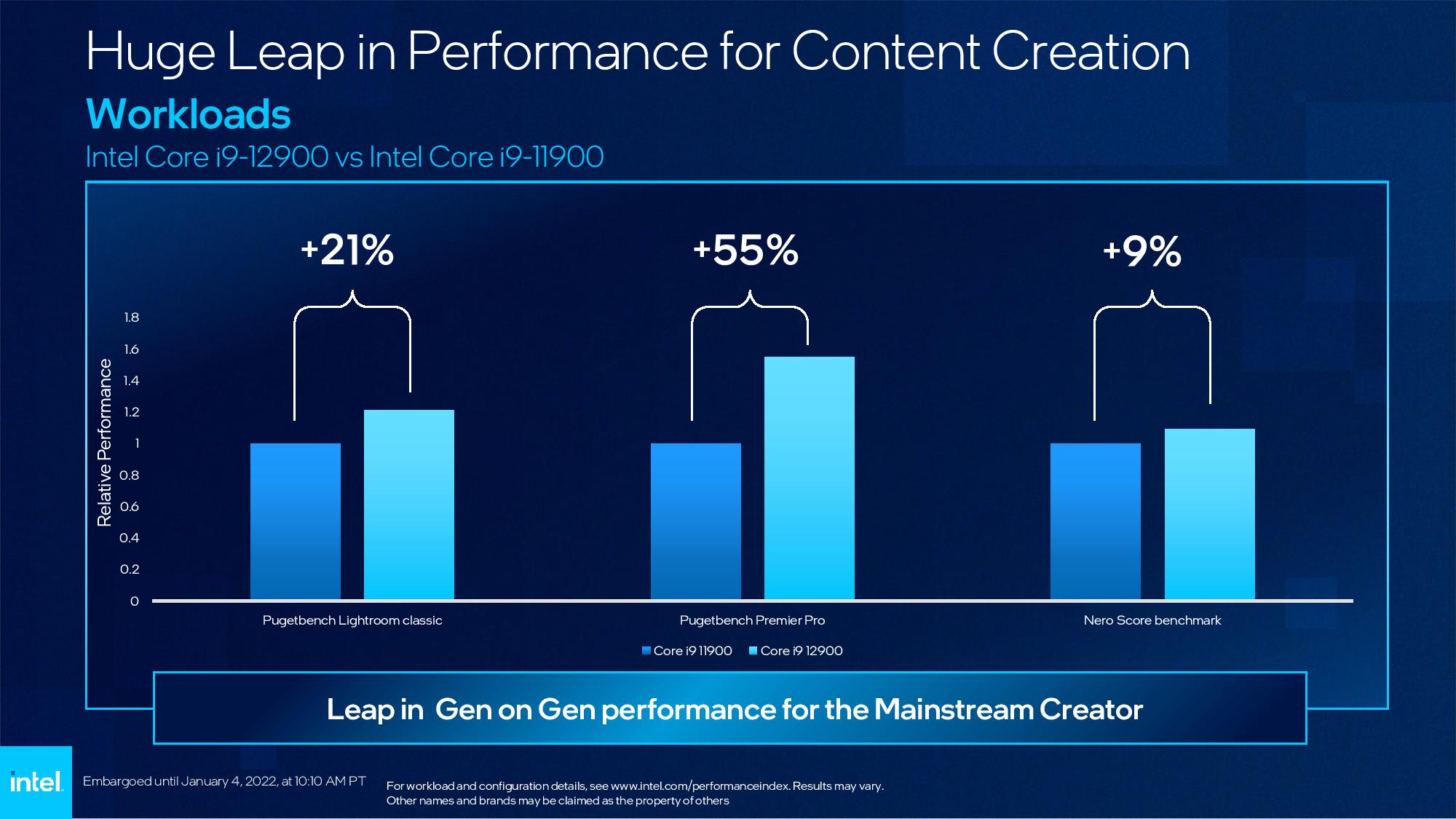
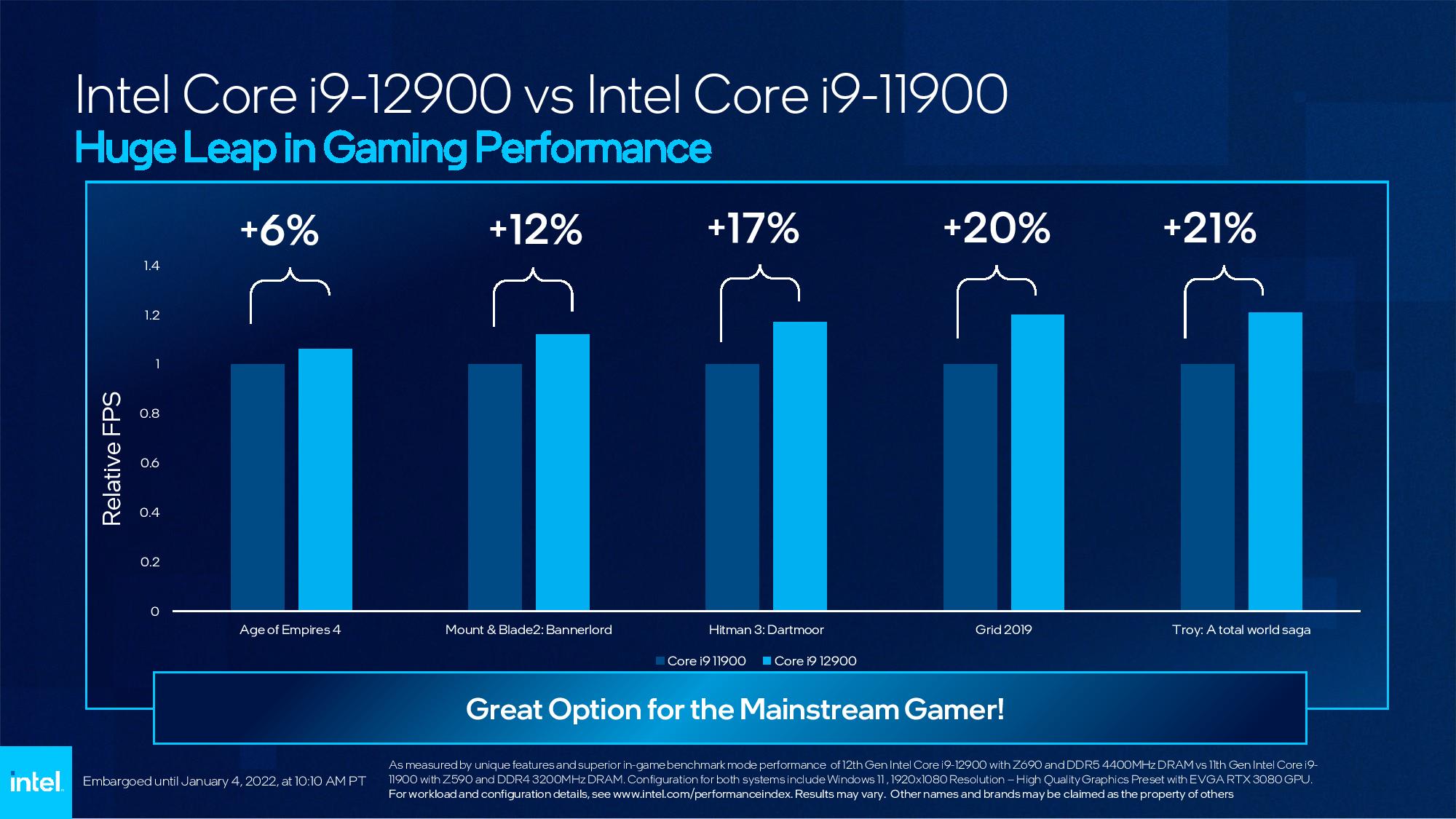
Here we can see Intel’s benchmarks from within its own test environment, but as with all vendor-provided benchmarks, take these with a grain of salt. Intel compared its Core i5-12600 and Core i9-129900 to the Ryzen 7 5700G in a range of productivity and creator workloads, and as you would imagine, those benchmarks reveal big wins for Intel’s chips.
Intel is looking to promote its highest-end Core i5 model here, but our own test results in the Core i5-12400 review show that the less expensive Core i5 beats the Ryzen 5 5600G across the board, and even challenges the Ryzen 5 5600X in most work. That’s to say that you could find equally impressive performance, but for less money, within Intel’s own stack.
Intel also showed impressive performance gains for the Core i9-12900 over the previous-gen i9-11900, positioning it as a great solution for mainstream gamers. Of course, you don’t need to spend that type of cash for mainstream gaming — head to our Best CPUs for gaming list for more rational recommendations.
Alder Lake Die Details
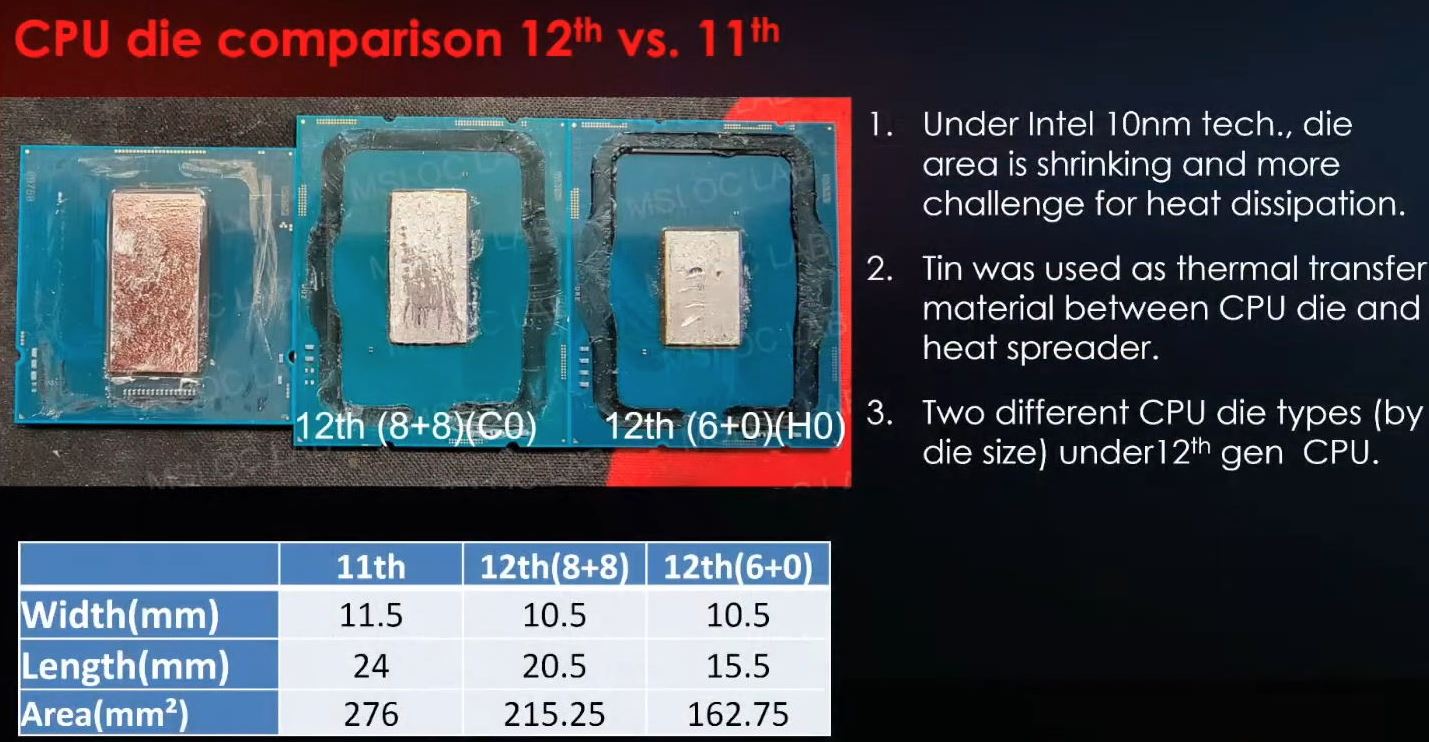
MSI recently confirmed via a livestream that Intel uses two different dies for the Alder Lake series: One die has eight P-cores and eight E-cores (8P+8E), and another has just six P-cores (6+0). Obviously, the latter die is much smaller and thus more cost-effective, therefore making far more sense for use in the non-hybrid Alder Lake chips with six or fewer cores.
However, leaked testing indicates that the Core i5-12400 chips vary on a chip-to-chip basis and can come with either die type. That means C0 stepping chips like ours actually have a total of eight P-cores and eight E-cores, but Intel disables the extra cores to trim it down to a 6+0 design. Naturally, that helps the company sell larger dies that encounter defects during manufacturing. It could also help improve supply and manufacturing efficiency when there aren't enough 'perfect' defect-free 6+0 dies available.
The physical difference between the dies — the 8P+8E design's ring bus extends to cover the disabled E-cores and P-Cores — implies that the H0-stepping 6+0 dies will have lower core-to-core latencies. That could theoretically lead to slightly faster performance under certain conditions. Additionally, anecdotal evidence also suggests that the H0 chips require less power. We're working to source an H0 chip for comparison. The Core i5 models appear to be the only non-hybrid chips that can come with either die type, but we’ve reached out to Intel for clarification.
Intel Laminar Stock Coolers
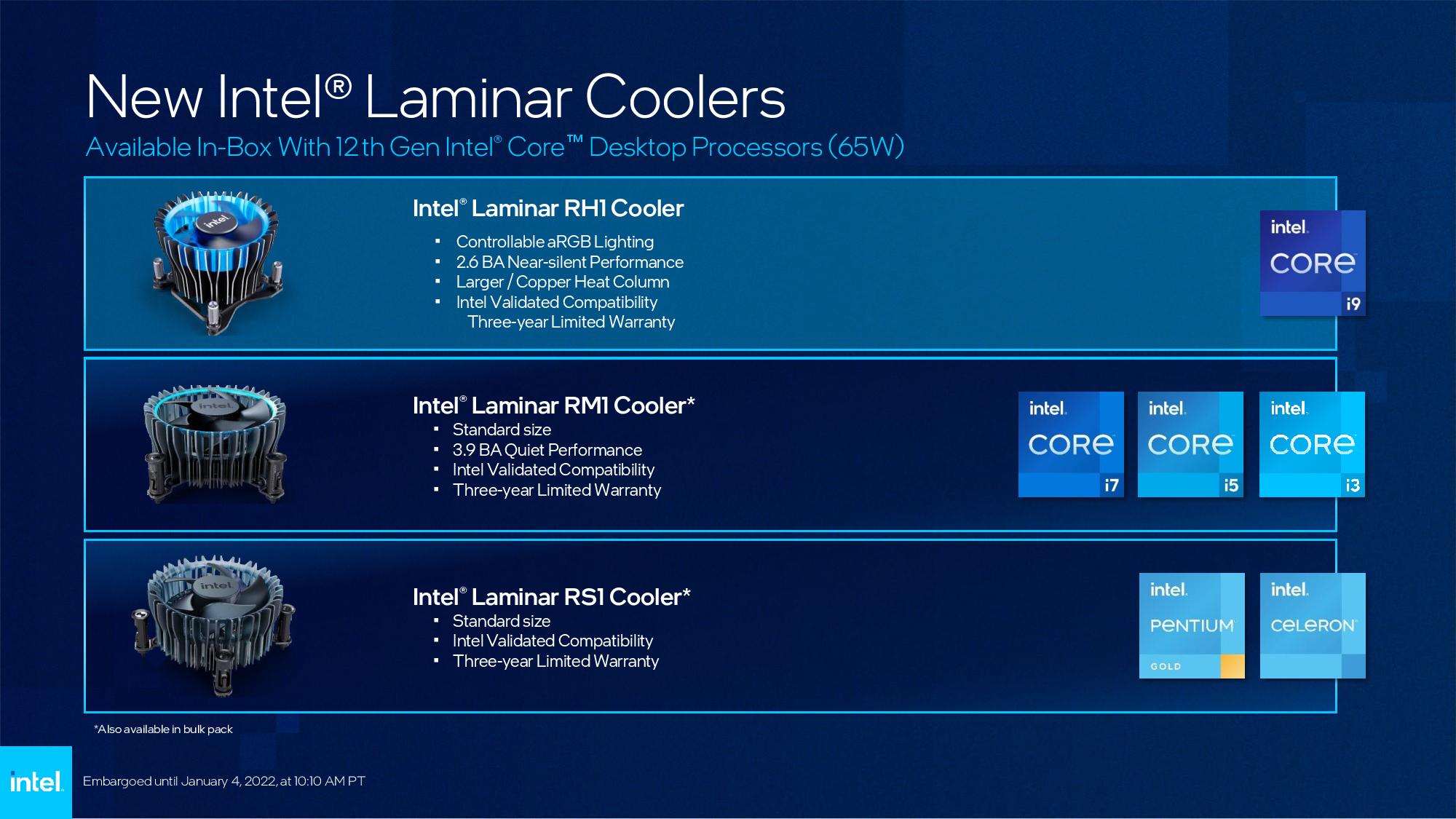
We’ve already seen signs of Intel’s new Laminar coolers in the wild, but now we have the full details. These coolers are designed to address two major deficiencies with Intel’s stock coolers: Thermal dissipation limitations and aesthetics. AMD’s stock coolers have long beat Intel in both of these departments, so this is a sorely-needed upgrade.
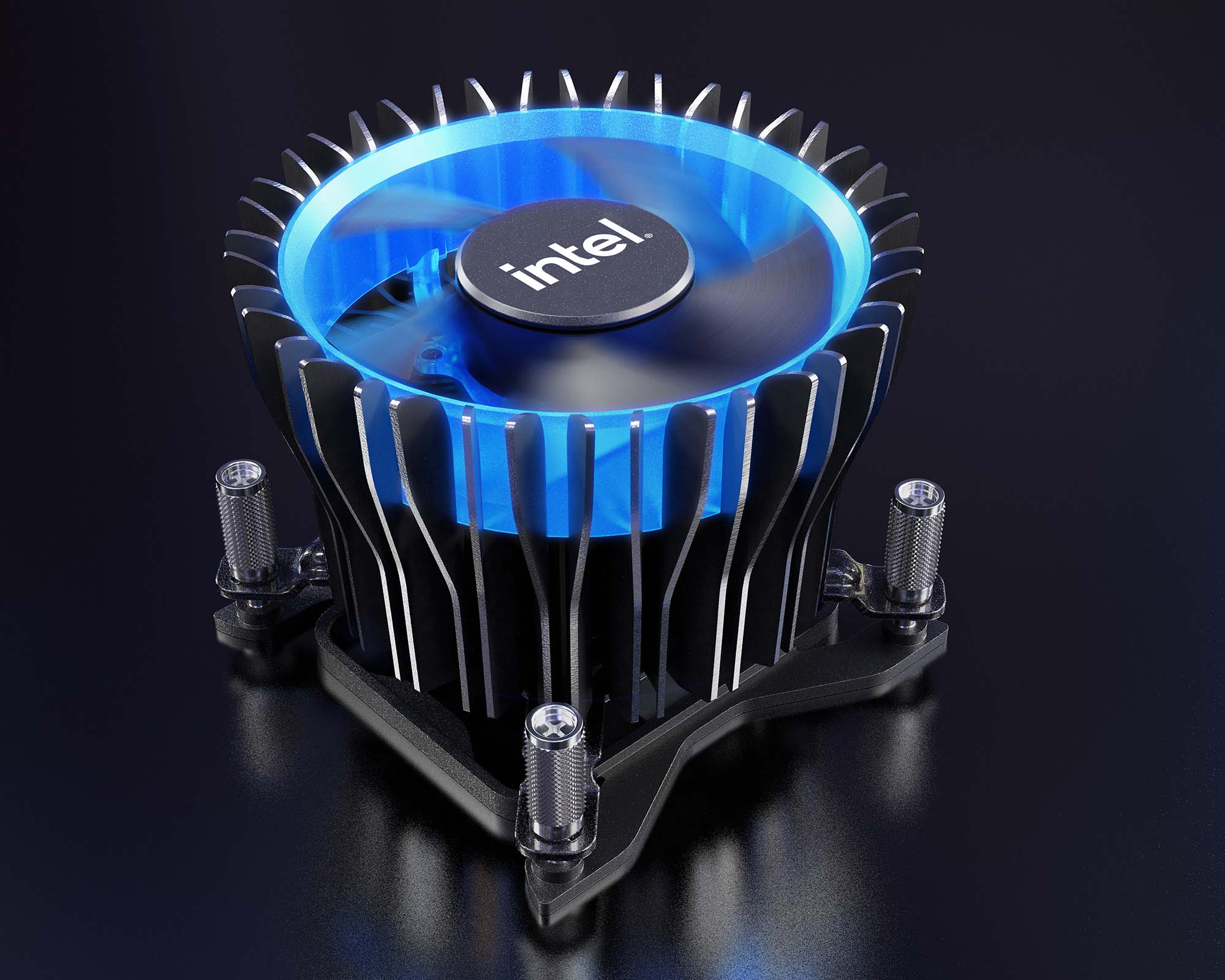
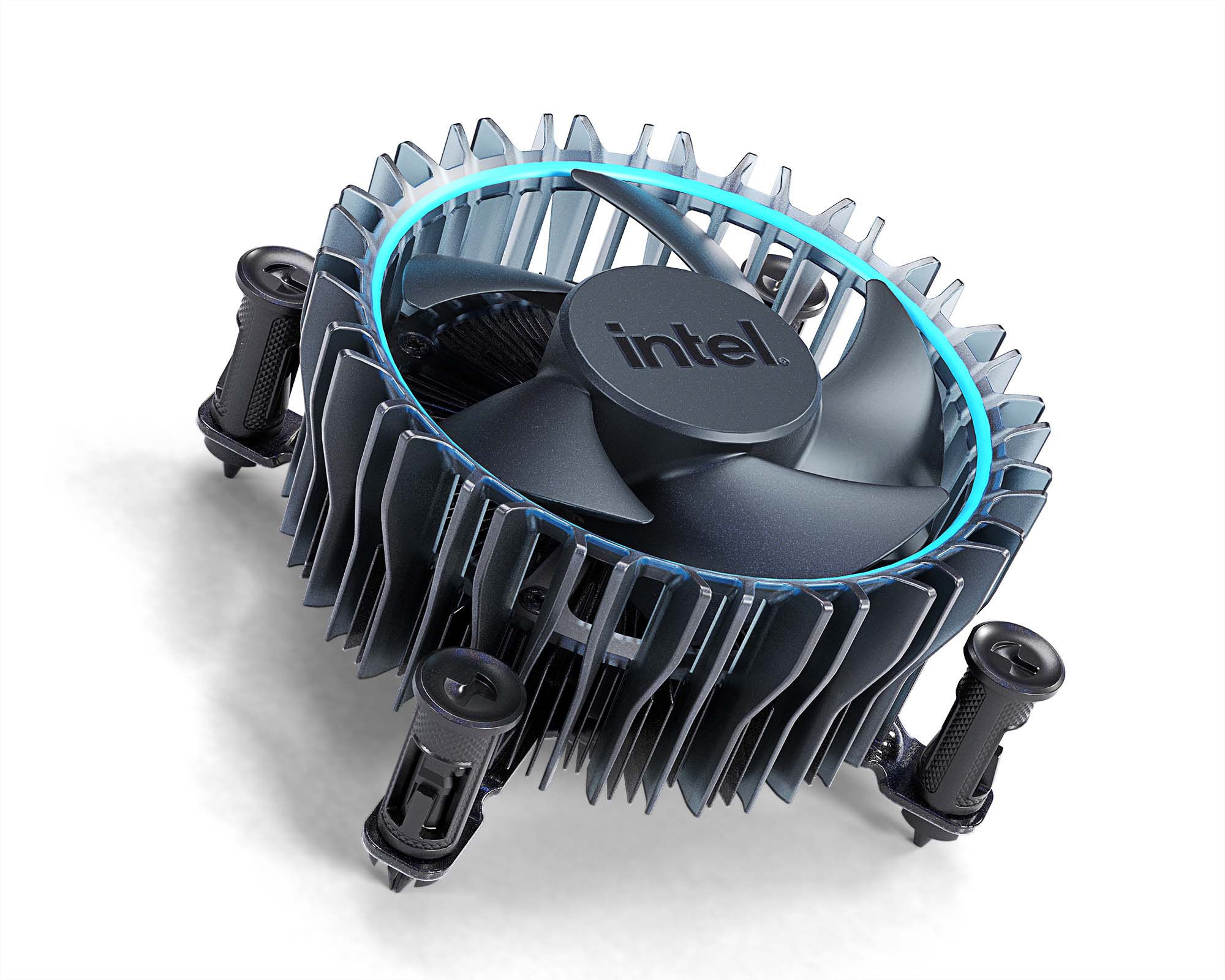
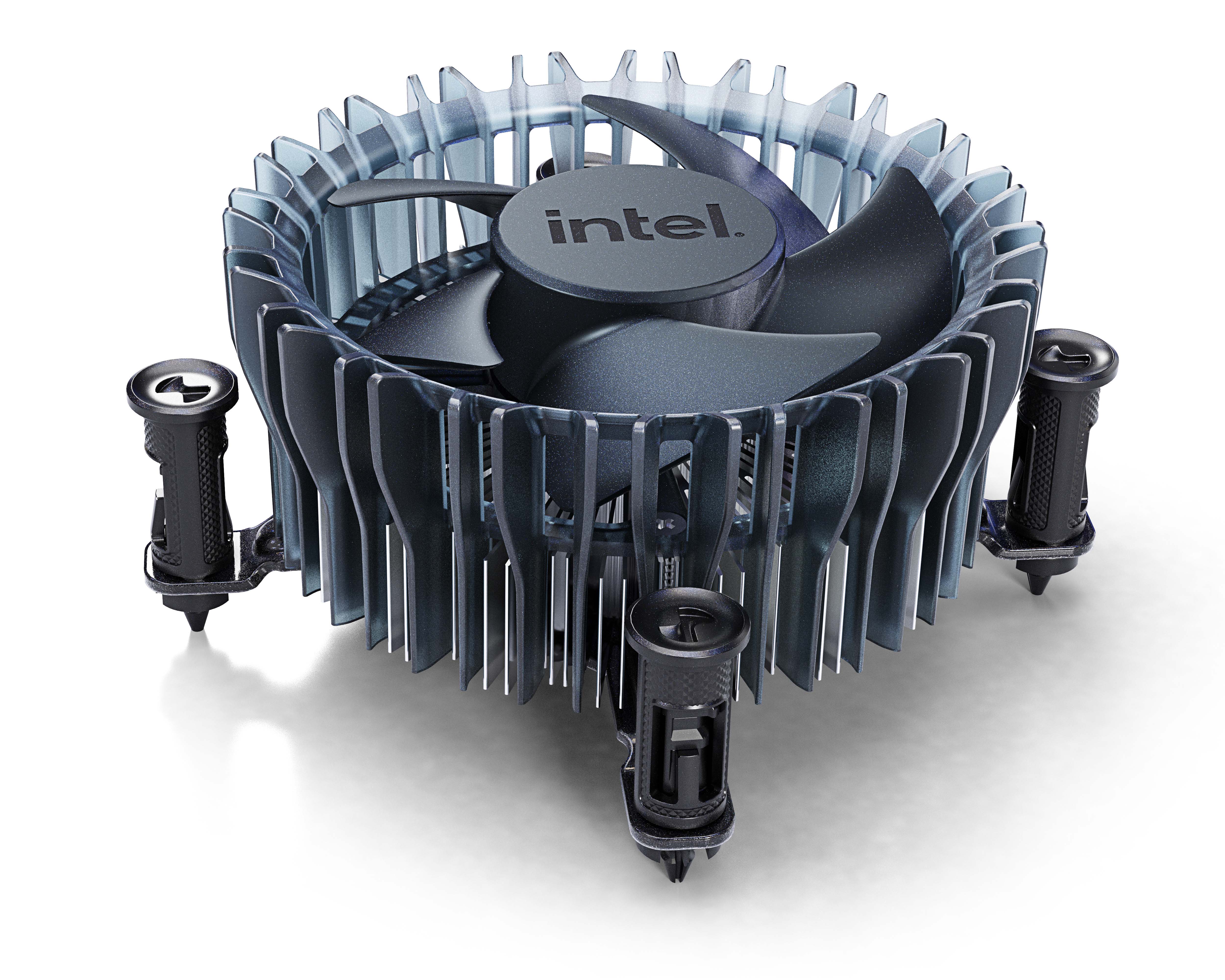
The Laminar coolers drop onto the LGA1700 socket and come in three variants. The Laminar RH1 has controllable aRGB lighting and features a large copper slug to improve thermal dissipation. Intel claims near-silent operation at 2.6 BA. This cooler ships with the locked Core i9 model.
The Laminar RM1 drops in for the Core i7, i5, and i3 non-K models and comes without RGB lighting (it does have a decorative blue ring lining the fin stack). Intel rates this cooler for ‘quiet performance’ at 3.9 BA. The Laminar RS1 rounds out the new family of coolers, but it’s the smallest of the bunch and will only ship with the lower-power Pentium and Celeron chips. This cooler doesn’t have a listed noise rating, so you should expect it to be fairly noisy.
Intel will also make these coolers available separate from the chips, but you have to buy them in lots of 1000. While that puts it out of reach for most of us to purchase directly from Intel, this means that we will eventually see these coolers filter out to retail outlets via third-party sellers. We’re working to source these coolers for in-depth testing; stay tuned.
Stay On the Cutting Edge: Get the Tom's Hardware Newsletter
Get Tom's Hardware's best news and in-depth reviews, straight to your inbox.
Intel H670, B660 and H610 chipsets
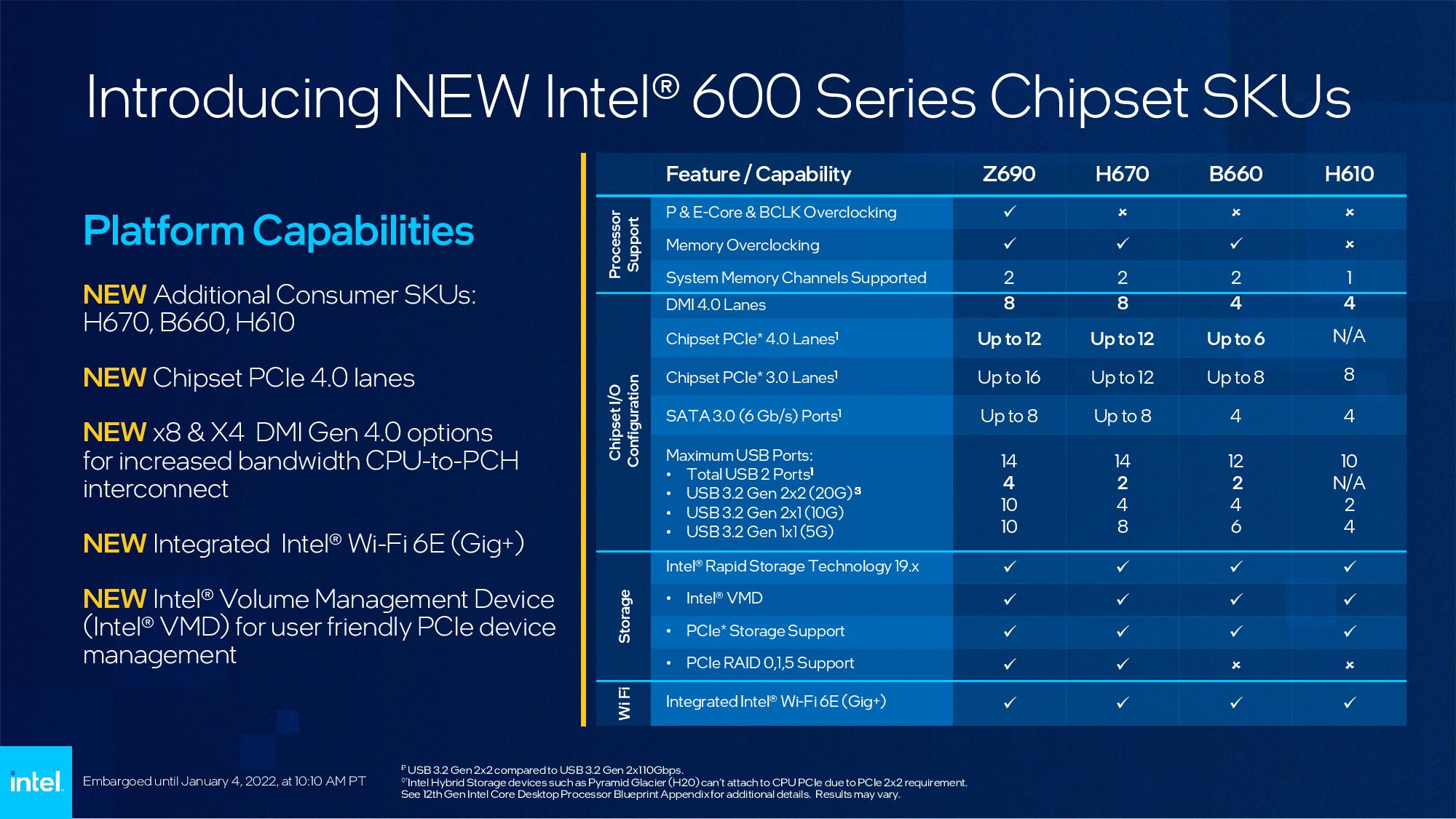
Intel’s pricing model with the Alder Lake chips is brutal — based on their performance, every model undercuts competing Ryzen 5000 chips by large margins. That means the Alder Lake chips are a great value, but the high pricing associated with the expensive Z690 motherboards has been a pain point that, in some cases, allows AMD to remain competitive on overall platform costs. Those high prices tend to stem primarily from support for DDR5 and the PCIe 5.0 interface. The DDR5 shortages, and resulting price scalping, certainly haven’t helped matters, either. Unfortunately, there are precious few high-end DDR4 Z690 options available.
Intel plans to address the high motherboard pricing issue with today’s release of the H670, B600, and H610 chipsets. We’re told that we should expect the new motherboards with these chipsets to predominantly support lower-cost DDR4 memory, and some will eschew the PCIe 5.0 interface to save costs.
Notably, memory overclocking is allowed with all Alder Lake processors, including locked models, on the B660 and H470 platforms. We have a much deeper breakdown of the new chipset features and a roundup of the motherboards we know about here, so head there for more detail.
Like the Alder Lake chips, the new motherboards begin shipping today.
- MORE: Best CPUs for Gaming
- MORE: CPU Benchmark Hierarchy
- MORE: AMD vs Intel
- MORE: All CPUs Content

Paul Alcorn is the Managing Editor: News and Emerging Tech for Tom's Hardware US. He also writes news and reviews on CPUs, storage, and enterprise hardware.
-
Why_Me The pricing of the B660 boards is going to be important. Hopefully they aren't in the $200 range.Reply -
larkspur Reply
https://www.tomshardware.com/news/intel-core-i5-12400-reviewsaltweaver said:How much will performance drop in 65W desktop processors? -
-Fran- Reply
ydgN4W97EskView: https://www.youtube.com/watch?v=ydgN4W97Esksaltweaver said:How much will performance drop in 65W desktop processors?
I gotta say, even at 65W, that thing is really good for the price. Let's see how the B660 boards stack in price, but they better be cheap. If they're a direct replacement to B560 (which, Z590 to Z690 wasn't), they'll be the new go-to budget option for sure.
Under that, I am willing to say going for the 6+0 configuration may even be a bad idea at this point. Them little cores are showing their weight more in lower TDP scenarios than high TDP ones, which is I think was Intel's long term play. Maybe? In any case, It would be nice if they could have a locked i5 with 4 E-cores at some point. That thing for sure will be the best CPU of the lineup for all gamers.
Regards. -
shady28 Reply-Fran- said:ydgN4W97EskView: https://www.youtube.com/watch?v=ydgN4W97Esk
I gotta say, even at 65W, that thing is really good for the price. Let's see how the B660 boards stack in price, but they better be cheap. If they're a direct replacement to B560 (which, Z590 to Z690 wasn't), they'll be the new go-to budget option for sure.
Under that, I am willing to say going for the 6+0 configuration may even be a bad idea at this point. Them little cores are showing their weight more in lower TDP scenarios than high TDP ones, which is I think was Intel's long term play. Maybe? In any case, It would be nice if they could have a locked i5 with 4 E-cores at some point. That thing for sure will be the best CPU of the lineup for all gamers.
Regards.
Yeah but are there any low end gamers left keeps coming to my mind.
Who's gonna stick a $300 cpu/mobo combo on a $800+ GPU (bottom end of what a 3060 Ti costs)? If I'm going to have to pay that kind of bank on a GPU on a new rig, I'm most likely going to go for more CPU than that.
ARC might be the savior. We'll see. That's probably bigger news. These low power AL chips are great, but I think will mostly benefit the OEM side until GPUs come down a lot. -
peachpuff Reply
$189 https://www.tomshardware.com/reviews/msi-mag-b660m-mortar-wifi-ddr4 dubbed inexpensive by the author :rolleyes:Why_Me said:The pricing of the B660 boards is going to be important. Hopefully they aren't in the $200 range. -
Why_Me Reply
That's a higher end B660 board imo.peachpuff said:$189 https://www.tomshardware.com/reviews/msi-mag-b660m-mortar-wifi-ddr4 dubbed inexpensive by the author :rolleyes:
This is the B560 equivalent of that board.
https://www.newegg.com/p/N82E16813144395MSI MAG B560M MORTAR WIFI $159.99 Save: $20.00 (11%) -
Why_Me Reply
Review done today with a B660 board.shady28 said:Yeah but are there any low end gamers left keeps coming to my mind.
Who's gonna stick a $300 cpu/mobo combo on a $800+ GPU (bottom end of what a 3060 Ti costs)? If I'm going to have to pay that kind of bank on a GPU on a new rig, I'm most likely going to go for more CPU than that.
ARC might be the savior. We'll see. That's probably bigger news. These low power AL chips are great, but I think will mostly benefit the OEM side until GPUs come down a lot.
https://www.guru3d.com/articles-pages/core-i5-12400-processor-review,1.html -
VforV These CPUs although have good performance for their price, the motherboards will be more expensive than the AM4 counterparts (as seen above), while also not having the option to OC the CPU (if you upgrade to a K SKU later), that's a big miss as a feature. So more expensive and no CPU OC = bad deal.Reply
I actually like more the SKUs without E-cores. All that hybrid thing has proven is not better, but mostly worse for games - see the benchmark with them disabled, the performance increases quite a lot in many games.
On that regard AL as a 1st gen is like Ryzen 1st gen = skipp-able. Too many issues, not optimized, growing pains and all the early adopter things, like decent prices for CPUs, but higher prices for the platform.
AL is viable only for someone that wants a new system, for everyone else already on AM4, not so much. If you already have a Zen3 CPU, AL is really a non-issue. -
m3city Productivity screenshot no 1: i5 12600 vs 5700G, the latter being slighly more expensive here in EU. Lets assume that those selected benchmarks show ~20% lead by Intel, shall we? Base power 125W, boost 150W. How much would Ryzen (TDP65W) go - 90W? From my point of view it's just more warm air to be moved from my SFF case. Intel is simply ineefective at high load. On idle it probably goes better than AMD. 5700G has an adequate cooler in box, 12600 doesn't - why? Is it just a matter of price? Why intel CPU's come without it?Reply